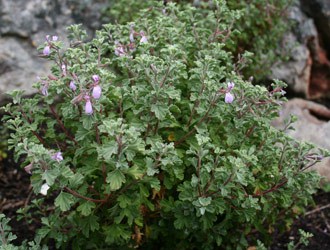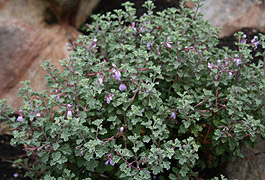Pelargonium exstipulatum
Pelargonium exstipulatum (Cav.) L'Hér.
Family: Geraniaceae
Common names: sweet-scented pelargonium, soft-leaved trifid pelargonium, scented penny-royal (Eng.); vaalblaarmalva (Afr.)
Introduction
Most of the species in the Geraniaceae family are very attractive, and Pelargonium exstipulatum is no exception. It adds some character to any garden, even when not in flower. The greyish-green foliage contrasts with the typical green foliage of most plants.

Description
Description
Pelargonium exstipulatum is a somewhat woody shrublet that can grow up to 1 m tall and 0.5 m wide. The stems are herbaceous when young and become woody as the plant matures. The leaves are an attractive greyish-green, lobed, velvety and strongly scented when crushed. They have a tacky feel when touched. The petioles (leaf stalks) often remain behind on the stems.

Pelargonium exstipulatum has a long flowering period starting in June through to December, therefore during winter and into summer in the southern hemisphere. There is a definite peak in spring. The flowers are borne on a peduncle which usually bears 1-5 light pink to purplish pink flowers. The two top petals are grouped together and have feather-like dark red to purple markings. The bottom three petals are separate and spoon-shaped. The 7 stamens are of different lengths and they produce orange pollen. The fruit is about 7 mm long and it has a tail that promotes wind dispersal.
In South Africa, we have about 5 genera and roughly 219 species of the Geraniaceae family.
Conservation Status
Status
Pelargonium exstipulatum is listed as Least Concern in the Red List of South African Plants (Raimondo et al. 2009). The species is restricted and endemic to the Little Karoo. However it is not known to be declining.
Distribution and habitat
Distribution description
Pelargonium exstipulatum grows in sandy soil in rocky habitats. Its distribution ranges from Ladismith to De Rust. The area in which it occurs is known as the Klein Karoo. The area is bordered on the southern side by the Langeberg and on the northern side by the Swartberg Mountains.

Derivation of name and historical aspects
History
The genus name Pelargonium is derived from the Greek word pelargos , meaning stork, and refers to the shape of the fruit which resembles the beak of a stork.The specific name is derived from the Latin word ex, meaning without, and stipula, meaning stipule. It refers to the inconspicuous stipules (leaf-like appendages at the base of a leaf) found on the plants.
Ecology
Ecology
In this genus the long, slender seed capsule splits open along the sides when dry, releasing the seeds. Each seed has a long, thin, feather-like, spiralling tail. The seed is dispersed by wind. Once the seed touches moist soil, it burrows its way into the soil by using the tail as a drill.
Uses
Use
There are no cultural or medicinal uses recorded for this plant.
Growing Pelargonium exstipulatum
Grow
Seeds or cuttings can be utilised for propagation. Stem cuttings can be taken at any time of the year. Select cuttings from healthy, vigorous plants. Take cuttings from the soft-wooded stems. A rooting hormone can be applied to enhance the rooting process. Place cuttings in a container filled with river sand. Keep cuttings moist and place them in either a cold frame or a place with adequate sunlight. The cuttings take approximately 3 weeks to root. Once rooted, the cutting can be transplanted into a container filled with a well-drained soil mix.
To propagate from seeds, sow the seeds in autumn or late summer. Fill a container with a well-drained soil mix. Spread the seeds evenly on the surface of the soil mix and cover with a thin layer of river sand. Place the seeds in light to medium shade and water with a fine spray. Seeds will germinate in approximately 2-3 weeks.
This pelargonium will grow well in a rockery. In a garden it will do best if grown in similar arid conditions as its natural habitat. It grows naturally in sandy soil in rocky places. It should be planted in a well-drained soil mix in a sunny position.
Pelargonium exstipulatum should best be planted with other plants that do not require much water. It is ideal for a water-wise garden.
References
- Goldblatt, P. & Manning, J.C. 2000. Cape plants. A conspectus of the Cape Flora of South Africa. Strelitzia 9. National Botanical Institute, Pretoria.
- Raimondo, D., Von Staden,L., Foden, W., Victor, J.E., Helme, N.A., Turner, R.C., Kamundi, D.A., Manyama, P.A. (eds) 2009. Red List of South African plants 2009. Strelitzia 25. South African National Biodiversity Institute, Pretoria.
- Van der Walt, J.J.A. & Vorster, P.J. 1981. Pelargoniums of southern Africa , vol. 2. Juta, Cape Town.
- Vlok, J., Schutte-Vlok, A. 2010. Plants of the Klein Karoo. Umdaus Press, Hatfield.
Credits
Olivia Tyambetyu
Millenium Seed Bank Partnership, Kirstenbosch
June 2012
Plant Attributes:
Plant Type: Shrub
SA Distribution: Western Cape
Soil type: Sandy
Flowering season: Spring, Early Summer, Winter
PH: Acid
Flower colour: Purple, Pink
Aspect: Full Sun
Gardening skill: Easy
Special Features:
Horticultural zones







Rate this article
Article well written and informative
Rate this plant
Is this an interesting plant?
Login to add your Comment
Back to topNot registered yet? Click here to register.